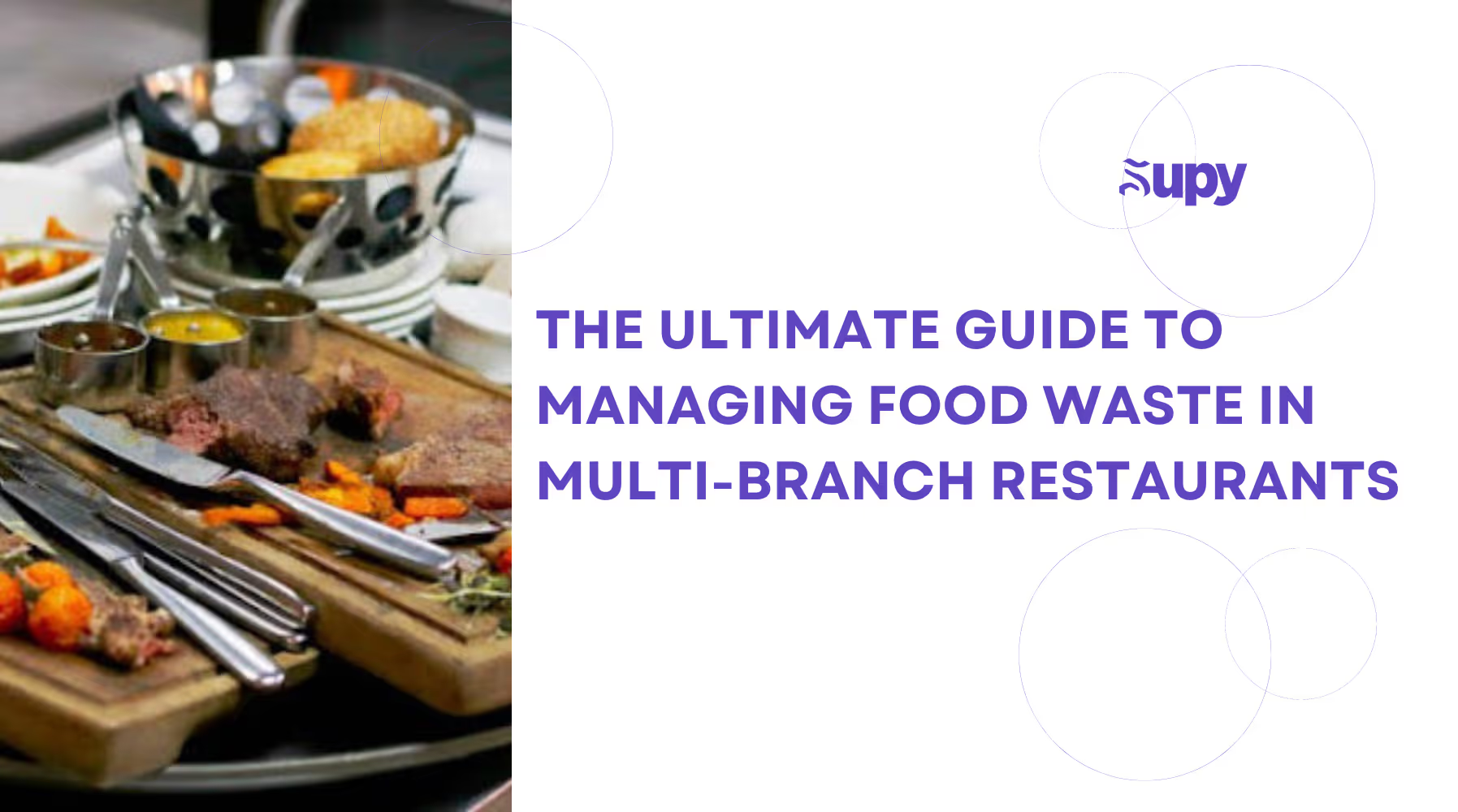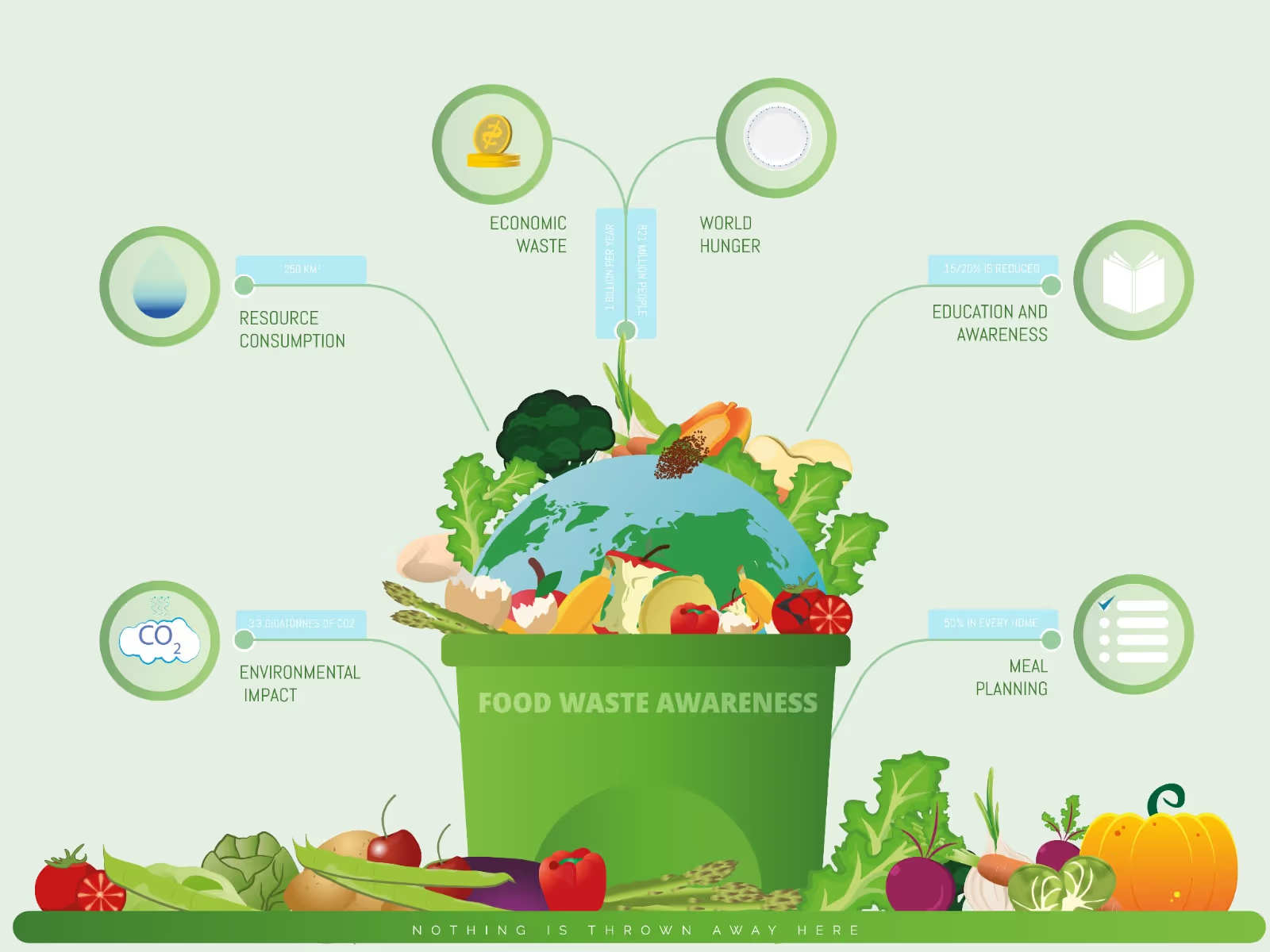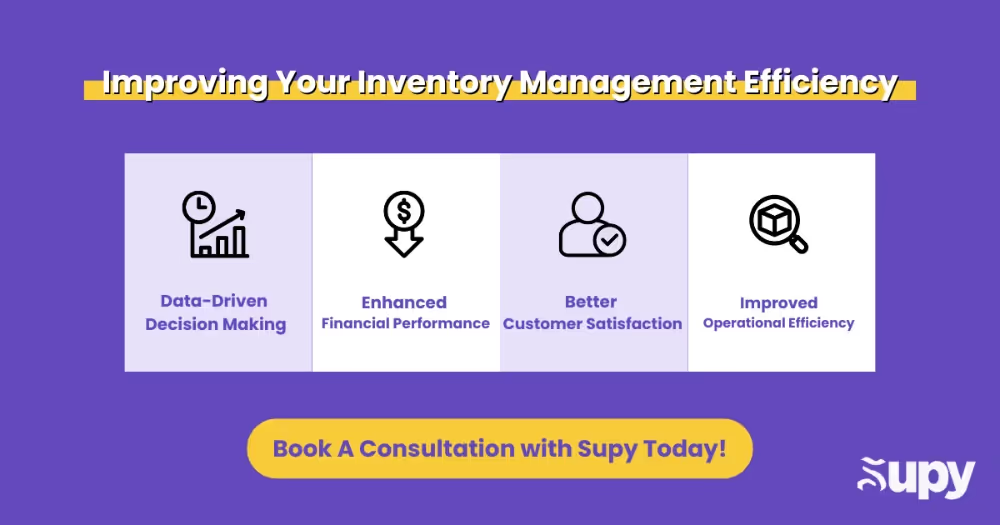The Ultimate Guide to Managing Food Waste in Multi-Branch Restaurants

Can you believe that a single restaurant can produce up to 75,000 pounds of Food Waste in Restaurants in a year? According to the Green Restaurant Association, this staggering amount of wasted food represents not just a loss of food but a significant drain on resources.
Globally, we waste one billion tons of food annually, according to the UN Environment Programme (UNEP). But what if you could turn this around for your restaurant?
In this guide, we’ll show you how to transform waste into efficiency. You’ll learn strategies to reduce food waste, save money, and promote sustainability across all your branches.
Here's what you'll learn:
- The Impact of Food Waste in the Restaurant Industry
- Major Causes of Food Waste in Restaurants
- Tips to Reduce Food Waste in Multi-Branch Restaurants
- Conclusion
- About Supy
Dive in and discover how you can turn the tide on food waste and create a more sustainable future for your restaurant operations.
1. The Impact of Food Waste in the Restaurant Industry

Food waste is a colossal issue in the restaurant industry, impacting both the environment and the bottom line. Understanding the scope and consequences of this problem is the first step towards finding effective solutions.
Environmental Impact
The environmental impact of food waste is profound. When excess food is wasted, all the resources that went into food production, processing, and transporting that food are also wasted.
According to the Food and Agriculture Organization (FAO) of the United Nations, if food waste were a country, it would be the third-largest emitter of global greenhouse gas emissions after the United States and China. Additionally, the decomposition of food waste in landfills produces methane, a greenhouse gas that is 25 times more potent than carbon dioxide in trapping heat in the atmosphere.
Economic Impact
Economically, food waste is a significant burden for restaurants. According to a report by ReFED, a national nonprofit dedicated to ending food loss and waste, U.S. restaurants lose about $25 billion each year due to food waste economically.
This loss not only affects profitability but also contributes to higher operating costs. For multi-branch restaurants, these costs can multiply, creating substantial financial challenges. Food waste affects not just the bottom line but also the overall efficiency of operations.
Social Impact
Food waste also has a social dimension. With millions of people around the world suffering from food insecurity, the waste of edible food is a glaring issue. The Natural Resources Defense Council (NRDC) estimates that reducing food losses by just 15% could feed more than 25 million Americans every year. Consumer food waste and unsold food contribute significantly to this problem, highlighting the need for better management practices.
The scale of food waste in restaurants is alarming, with significant implications for the environment, economy, and society. Addressing this issue is crucial for creating a more sustainable and efficient foodservice industry.
2. Major Causes of Food Waste in Restaurants

Understanding the primary causes of food waste in restaurants is crucial for developing effective waste reduction strategies. Let's explore some of the major contributors to food waste in the industry.
- Over-Preparation: Preparing more food than necessary to meet peak demand often leads to excess that must be discarded. Over-preparation is a common issue in many restaurants.
- Spoilage: Poor storage, improper temperature control, and inadequate stock rotation cause ingredients and prepared foods to spoil before they can be used. Spoilage significantly contributes to food waste in the foodservice industry.
- Plate Waste: Customers leaving uneaten food on their plates due to large portion sizes, unappetizing dishes, or personal preferences. Plate waste is a considerable factor in full-service restaurants.
- Inefficient Inventory Management: Over-ordering or underutilizing ingredients due to poor tracking of stock levels and expiration dates leads to significant waste.
- Menu Design: Extensive menus requiring a diverse range of ingredients can result in surplus ingredients that spoil before they are used.
- Staff Practices: Inadequate training on portion control, improper food handling, and lack of awareness about waste reduction practices contribute to food waste.
Supply Chain Issues: Disruptions such as delayed deliveries or incorrect orders can result in spoiled produce or surplus inventory that cannot be utilized in time.
3. Tips to Reduce Food Waste in Multi-Branch Restaurants

Reducing food waste in multi-branch restaurants requires a strategic approach that integrates best practices across all locations. Here are some actionable tips and food waste solutions to help you achieve significant reductions in food waste.
Conduct Regular Waste Audits
Regular waste audits are essential for understanding and managing food waste effectively. By systematically evaluating the type and amount of waste generated at each branch, you can identify problem areas and implement targeted solutions.
How to Do It:
- Categorize Waste: Separate waste into categories such as pre-consumer (e.g., kitchen waste) and post-consumer (e.g., plate waste). Use color-coded bins to make categorization easy for staff. Educate your team on the importance of correctly sorting waste to ensure accurate data collection.
- Track Data: Use tracking sheets or digital tools to log waste amounts and types. Choose user-friendly software that integrates with your existing systems. Regularly review the data with your team to keep everyone informed and engaged in waste reduction efforts.
- Analyze Patterns: Identify trends and common sources of waste. Look for recurring issues, such as specific dishes frequently left uneaten or ingredients that often spoil. Use this information to adjust inventory orders and procure ingredients accordingly. Additionally, ensure you store food properly to extend its shelf life and reduce spoilage.
Optimize Inventory Management
Implementing efficient inventory management practices is essential to minimize over-ordering and spoilage, thereby reducing food waste.
How to Do It:
- Use Inventory Management Software: Tools like Supy provide real-time data on stock levels, helping to avoid over-purchasing. This software can automate reordering processes and keep track of expiration dates, ensuring that inventory is always fresh and in optimal condition. Integrating such tools into your food system can streamline operations and enhance efficiency.
- First-In, First-Out (FIFO): Ensure older stock is used first to prevent spoilage. Train staff on the importance of this method and monitor compliance regularly. Proper implementation of FIFO can significantly reduce waste by ensuring that older inventory is utilized before it becomes unusable.
- Regular Stock Checks: Conduct frequent inventory checks to keep track of what's on hand and its condition. Use these checks to adjust future orders based on actual usage patterns and reduce excess stock. Regular monitoring helps in identifying slow-moving items and adjusting procurement strategies accordingly. A well-managed food system is critical to reducing waste and maintaining quality.
Standardize Portion Sizes
Ensuring consistent portion sizes across all branches can significantly reduce plate waste and improve customer satisfaction.
How to Do It:
- Create Portion Guides: Develop detailed guides and train staff on proper portion sizes for each dish. Make these guides easily accessible in the kitchen and include visual aids for clarity. Regular training helps ensure all staff members are aligned.
- Use Measuring Tools: Equip kitchens with scales, scoops, and portion control tools to ensure accuracy. Consistent use of these tools helps maintain correct portion sizes and prevent food waste. Regularly calibrate these tools to maintain their accuracy.
- Monitor Portions: Regularly review and adjust portion sizes based on customer feedback and waste data. Analyze plate waste to identify patterns and make necessary adjustments. This continuous monitoring process is essential to prevent wasted food effectively.
Menu Engineering
Designing a menu that maximizes ingredient use and minimizes waste is key to efficient restaurant operations and sustainability. By adapting food waste solutions like menu engineering, you can optimize your offerings and reduce waste.
How to Do It:
- Analyze Sales Data Analytics: Identify best-selling and underperforming items using sales data analytics. Use these insights to understand which dishes are popular and which are not. Focus on keeping top-selling items and consider removing or reworking dishes that consistently underperform. This helps streamline the menu and reduce the need for rarely used ingredients.
- Streamline Menu Items: Reduce the number of menu items that require unique ingredients. Opt for versatile ingredients that can be used across multiple dishes. This not only simplifies inventory management but also reduces the risk of spoilage by ensuring perishable foods are used up more quickly. Incorporate local food options to enhance freshness and sustainability.
- Feature Daily Specials: Use surplus ingredients in daily specials to prevent waste. Daily specials can be an effective way to utilize ingredients that might otherwise go to waste. This approach allows for flexibility in the menu and helps keep offerings fresh and interesting for customers.
Implement Staff Training Programs
Training staff on waste reduction practices is essential to minimizing waste and promoting a culture of sustainability across all branches.
How to Do It:
- Educational Workshops: Hold regular training sessions on best practices for food handling, storage, and portioning. These workshops should cover the importance of minimizing waste and the specific techniques staff can use to achieve this. Interactive and practical sessions can help reinforce the learning and ensure staff are equipped to implement these practices.
- Incentivize Waste Reduction: Create reward systems for staff who actively reduce waste. Recognize and reward those who come up with innovative ideas to minimize waste or consistently follow best practices. This could include bonuses, employee of the month awards, or other incentives that motivate staff to contribute to waste reduction efforts.
- Promote a Culture of Sustainability: Encourage staff to suggest and implement waste-reduction ideas. Foster an environment where staff feel comfortable sharing their thoughts and suggestions on how to reduce waste. Regularly gather feedback and involve staff in the decision-making process to enhance their commitment to sustainability initiatives.
Leverage Technology
Using technology to streamline operations and reduce waste can significantly enhance efficiency and sustainability in your restaurant. Inventory management systems like Supy are essential for this process, providing real-time data and automating key tasks.
How to Do It:
- Waste Tracking Apps: Implement apps that help track and analyze food waste. These apps can provide insights into where waste is occurring and suggest actionable steps to reduce it. Regularly reviewing the data collected can help in making informed decisions about menu adjustments and operational changes.
- Smart Kitchen Equipment: Invest in technology such as temperature sensors and automated portioning tools. Temperature sensors ensure food is stored at optimal conditions, preventing spoilage, while automated portioning tools help maintain consistent portion sizes, reducing the risk of over-serving.
- Customer Feedback Systems: Use digital platforms to gather customer feedback on portion sizes, menu preferences, and dining experiences. This feedback can help you make data-driven decisions to adjust portion sizes and menu offerings, ultimately reducing waste.
Improve Supply Chain Management
Enhancing supply chain practices is crucial to preventing delays and reducing spoilage, thereby minimizing food waste in your restaurant.
How to Do It:
- Build Strong Supplier Relationships: Maintain consistent communication with suppliers to ensure timely and accurate deliveries. Strong relationships lead to better terms and quick issue resolution.
- Flexible Ordering: Adjust order quantities based on real-time sales and inventory data. Use dedicated software for seamless procurement, automating and optimizing the ordering process to prevent over-ordering and spoilage. This integration can significantly improve back-of-the-house operations, ensuring that inventory is managed efficiently.
- Regular Communication: Keep open lines of communication with suppliers to manage expectations and address issues promptly. Regular check-ins help identify potential problems early, ensuring alignment on delivery schedules and quality standards.
Engage Customers
Involving customers in your waste reduction efforts can significantly enhance your sustainability initiatives and improve customer satisfaction.
How to Do It:
- Promote Mindful Eating: Educate customers about the importance of reducing food waste through menu notes or signage. Highlight the environmental and economic benefits of mindful eating, making them feel part of the solution. Inform them about how reducing waste can positively impact the community and the planet.
- Create Customizable Dishes: Offer customizable dishes where customers can choose the ingredients and portion sizes that fit their preferences. This not only reduces plate waste but also enhances the dining experience by catering to individual tastes and dietary needs.
- Offer Incentives for Participation: Provide incentives for customers who participate in your waste reduction efforts, such as discounts or loyalty points for finishing their meals or providing feedback. Consider partnering with initiatives like Too Good To Go, which helps reduce food waste by offering surplus food at a discount. This not only helps in waste reduction but also increases brand visibility in a positive way.
4. Conclusion
Taking proactive steps to reduce food waste in your multi-branch restaurants is essential for promoting sustainability and improving profitability. Understanding the impact of food waste, addressing its major causes, and adopting best practices can significantly lower your waste levels. Leveraging technology, enhancing supply chain management, and engaging customers in your efforts will further bolster your waste reduction initiatives. These actions will not only streamline your operations but also position your restaurant as a responsible and environmentally-conscious business, paving the way for a sustainable future.
5. About Supy
Supy is a powerful restaurant inventory management software designed to help multi-branch and enterprise restaurants streamline operations, reduce food waste, and maximize profits. By providing real-time data and accurate insights, Supy enables restaurants to make informed decisions and efficiently manage their inventory.
For more insights on reducing food costs and waste in multi-branch restaurants, check out our eBook: The Ultimate Guide To Reducing Food Cost In Multi-Branch & Enterprise Restaurants.
To see how Supy can transform your restaurant, schedule a demo with us today.







